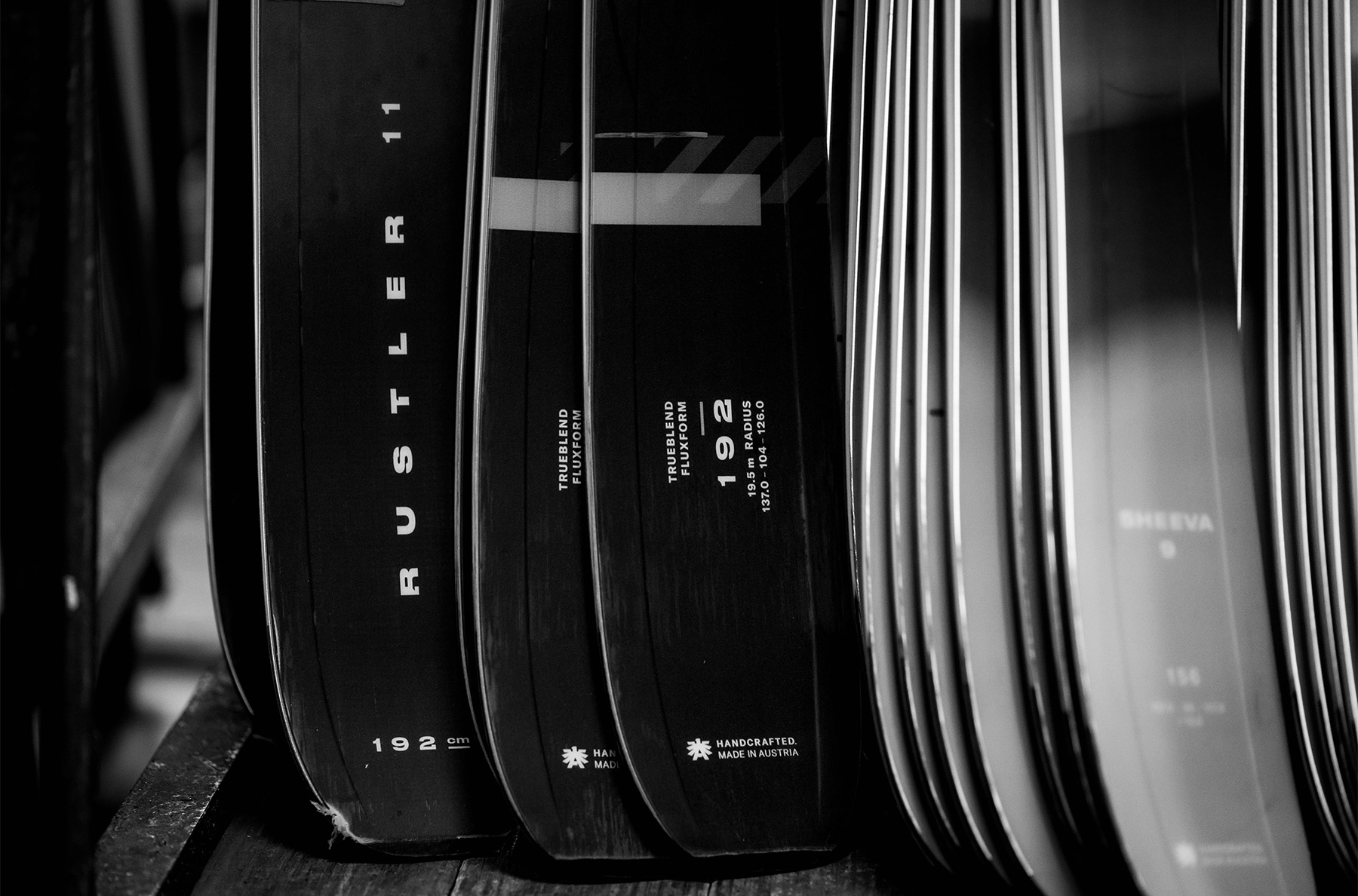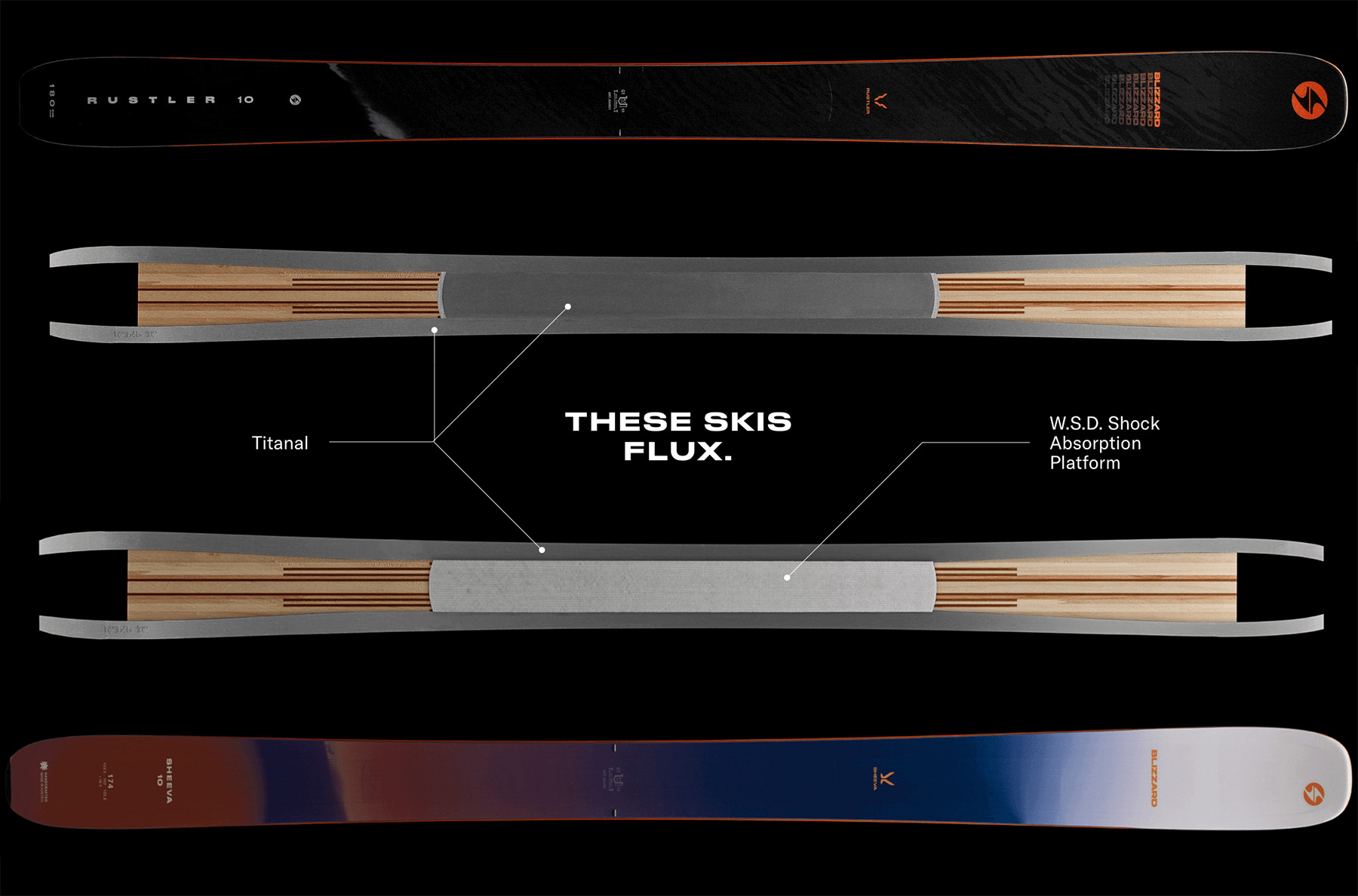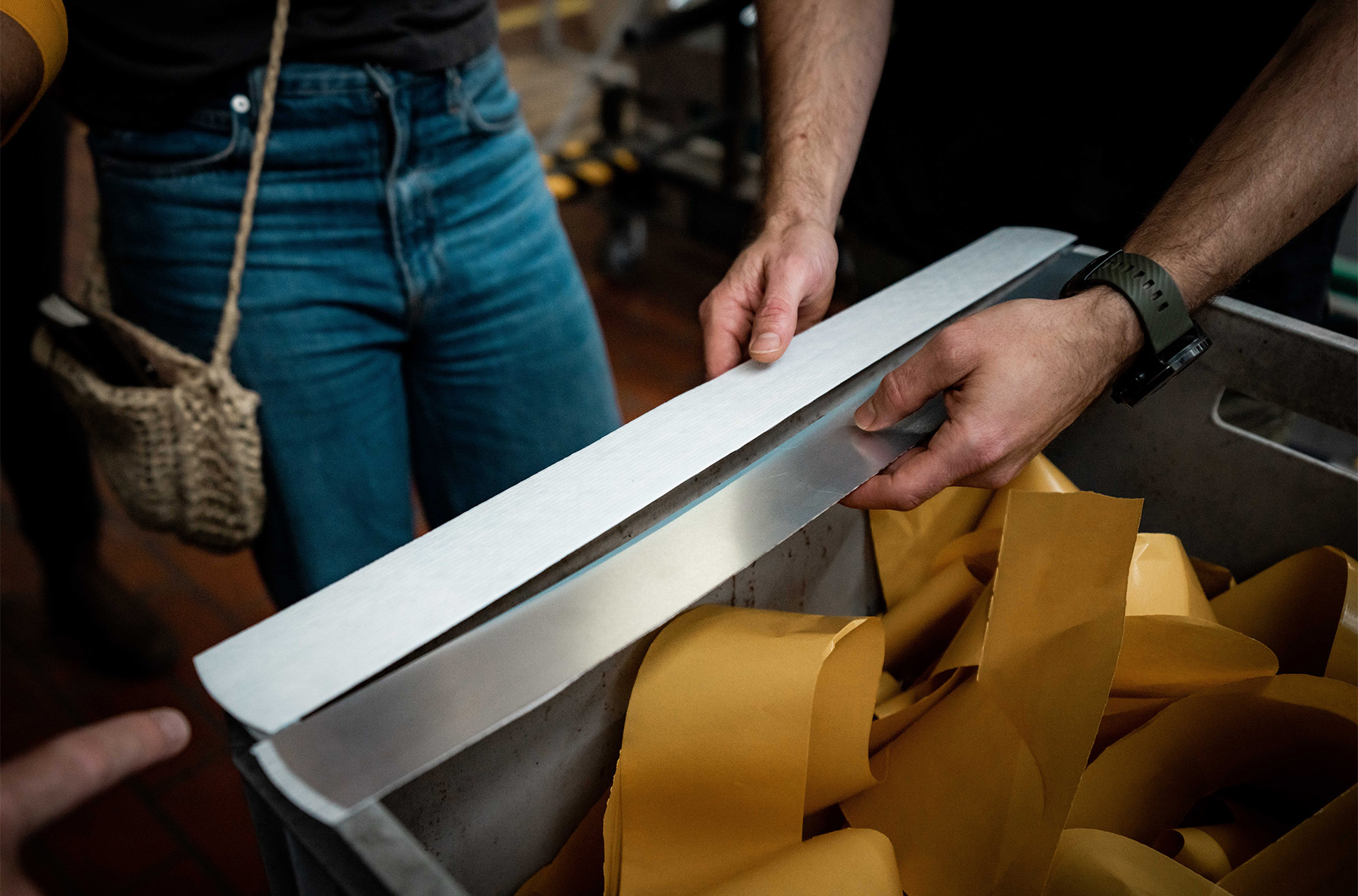
Today Blizzard announced the latest generation of their freeride Rustler and Sheeva skis.
This past fall, our senior editor, Kristin Sinnott, was over in Austria learning about the new skis and getting the updated Sheeva 9 and Sheeva 10 on snow; Blister Members can check out her initial impressions in her Flash Review. We’ll be spending lots of time on several of the new Rustlers and Sheevas this season, but in the meantime, let’s dive into what’s changed:
Trueblend Freeride Core
Mirroring what we’ve seen from Blizzard’s new skis over the past couple years, the 23/24 Rustler and Sheeva skis feature a version of Blizzard’s “Trueblend” wood core, which consists of a variety of precisely placed stringers of poplar, paulownia, and beech woods. The goal is to put denser, stiffer materials (i.e., the beech) where you need them, while placing lighter, softer materials (paulownia and poplar) where stiffness is less of a priority and you’re instead looking to minimize swing weight. While many skis’ wood cores contain a variety of stringers of different types of wood, Blizzard’s Trueblend construction seems to be notably more complex and allows for finer-tuning of core characteristics.

FluxForm & FluxForm W.S.D.
The previous Rustler and Sheeva skis featured a single piece of metal that spanned edge-to-edge underfoot but tapered to a point toward the tips and tails, with the goal of providing torsional rigidity and edge hold around the middle of the ski, without making the tips and tails difficult to release.
The 23/24 models feature a construction that reportedly aims to accomplish similar goals, but goes about doing so in a different manner. Dubbed “FluxForm,” this approach involves two separate pieces of titanal that run over the edges from tip to tail, tapering as they get closer to the extremities. On the Rustler skis, there’s also a piece of titanal under the binding area, whereas the women’s Sheeva models use a layer of fiberglass in that area.


Same as before, the implementation of FluxForm varies by model, with the firmer-snow-oriented Rustler 9 and Sheeva 9 having more metal than the softer-snow-oriented Rustler 10, Rustler 11, Sheeva 10, and Sheeva 11.
Models & Specs
On paper, the stated specs of the new Rustler and Sheeva skis don’t look wildly different than their predecessors, but there are some tweaks across the board; here’s a brief rundown of the stated specs for the 23/24 skis:
2023-2024 Blizzard Rustler 9

Stated Dimensions (180 cm): 131.5-96-121 mm
Available Lengths: 162, 168, 174, 180, 186 cm
Stated Sidecut Radii: 14, 15 16, 17, 18 m
Stated Weight per Ski (180 cm): 1935 grams
2023-2024 Blizzard Rustler 10

Stated Dimensions (180 cm): 134-102-123 mm
Available Lengths: 162, 168, 174, 180, 186, 192 cm
Stated Sidecut Radii: 14.5, 15.5, 16.5, 17.5, 18.5, 19.5 m
Stated Weight per Ski (180 cm): 1995 grams
2023-2024 Blizzard Rustler 11

Stated Dimensions (186 cm): 142-114-132 mm
Available Lengths: 168, 174, 180, 186, 192 cm
Stated Sidecut Radii: 16, 17.5, 19, 20.5, 22 mm
Stated Weight per Ski (186 cm): 2065 grams
2023-2024 Blizzard Sheeva 9

Stated Dimensions (164 cm): 129-96-118.5 mm
Available Lengths: 150, 156, 162, 168, 174 cm
Stated Sidecut Radii: 12, 13, 14, 15, 16 m
Stated Weight per Ski (164 cm): 1765 grams
2023-2024 Blizzard Sheeva 10

Stated Dimensions (164 cm): 133.5-102-122.5 mm
Available Lengths: 156, 162, 168, 174, 180 cm
Stated Sidecut Radii: 13.5, 14.5, 15.5, 16.5, 17.5 m
Stated Weight per Ski (164 cm): 1735 grams
2023-2024 Blizzard Sheeva 11

Stated Dimensions (172 cm): 140-112-130 mm
Available Lengths: 162, 168, 174, 180 cm
Stated Sidecut Radii: 16, 17.5, 19 m
Stated Weight per Ski (172 cm): 1825 grams
For reference, below is the whole press release from Blizzard:
Blizzard Launches All-New Freeride Collection
New Athlete-driven Rustler and Sheeva models are completely redesigned and built to PRESS SEND.
Blizzard proudly introduces the next generation of their best-selling freeride skis, Rustler and Sheeva, fully reengineered to pop, drop or float off anything and everything thrown their way. From new molds to new construction technologies, there’s no shortage of Austrian-grade innovation in these skis. But ask anyone on the development team, from athletes to engineers, and they’ll tell you more than anything, these skis are about delivering that “feeling” that keeps the freeriders of the world frothing for more.
“Whenever I speak to athletes about the products we make and what it is about their favorite skis, they all seem to use words that try to describe a specific balance or sweet spot,” said Frank Shine, Blizzard Creative Marketing Manager. “It’s hard to put into words, but you know it when you feel it, and if we continue to push ourselves to make skis with this magic swag that has our athletes coming back for more, then we are heading in the right direction.”
Blizzard’s product development team turned to their team of accomplished freeride athletes throughout every phase of development, gathering insights for what could be improved, what needed to remain the same, and testing prototype after prototype to nail their vision. Their goal was to make a ridiculously fun ski that would pop and float in playful terrain, while balancing the flex of the ski for improved confidence at high speeds or variable conditions. A lofty order, but that’s just the kind of progressive challenge that motivates Blizzard.
THE TECH
At the heart of the skis lies the Trueblend Freeride Woodcore, which positions different densities of wood at varying lengths throughout the core, resulting in stiffness underfoot, softness in the tip and tail, and a specifically designed flex for every length of every model. To ensure the requested playfulness without compromising stability, they reimagined the use of Titinal with FluxForm – three sections specifically shaped and placed to make the ski stable under foot, yet torsionally soft and forgiving in the tip and tail. When combined with their newly designed sidecut and rocker profiles, all of which are different for every length of ski, Blizzard aims to deliver an energetic freeride ski that delivers that ‘hell yes’ feeling of being alive when you click your poles and drop into that spicy chute, a field of glory pow, or stomp a line like you owned it.
The new Rustler series comes in three models: the Rustler 11, available in five lengths from 168 to 192 cm; the Rustler 10, available in six sizes from 162 to 192 cm; and the Rustler 9, available in five lengths, from 162 to 186 cm.
The Sheeva models, designed in collaboration with their Women2Women group, share the same energetic freeride spirit, but have some construction tweaks to achieve the desired performance and feeling for ladyshredders.
“We worked with our female ambassador and athlete groups throughout the development process to ensure that we were making a collection of freeride skis that would work for all levels of women,” explained Leslie Baker-Brown, Blizzard Tecnica Women2Women Project Lead. “Because the skis are specifically engineered at each length and we’ve shortened the length increments, we really are able to reach a broader range of skiers.”
The new Sheeva series comes in three models: the Sheeva 11, in three lengths from 168 to 180 cm; the Sheeva 10, available in five lengths from 156 to 180 cm, and the Sheeva 9, available in five sizes, from 150 to 174 cm.
“Blizzard is doubling down on the activation of our promotional teams, and making sure that the correct athletes are plugged in with our development process,” said Shine. “From concepts to final prototypes — our Freeride Team and W2W Program will be at the heart of our craft. We are in the middle of an epic three to four year cycle of new Blizzard skis that is going to make things really fun for our crew.”
The new Rustler/Sheeva models will be available at select retailers for an early intro in January 2023, with full retail launching in fall of 2023.
For more information, please visit the Rustler Sheeva website here or contact Maro LaBlance at maro@campfire-collective.co.

Love that the 10 goes up to a 192, don’t love that I’m now regretting buying new skis earlier this season
^This
“Hey Volkl, go Flux yourself!” – Blizzard
I’m now curious how the rustlers compare with the titanal frame skis from Volkl.
Yes, I wonder how they ski compared to V-Werks Katana (112 mm underfoot, 23.5 m radius vs. Rustler 11 is 114 mm & 22 m radius). Katana are carbon and would be lighter and and less damp but curious how they compare on snow feel, float, and turning characteristics.
The Hustle (r) has carbon similar to the V-Works. Since the Hustle and old Rustler weighed about the same it makes sense for a bigger distinction in the construction between the two besides just the carbon. They’ve taken Black Crows H-shaped metal to it’s maximum conclusion. I’m interested.
I am hopeful that the redesign Rustler truly corrects the weaknesses of the original rustler 11 that is resulting in me selling the ski. In the 174 length, the hinge point in the shovel is very noticeable! This makes the shovel feel perceivably soft and very unbalanced compared to the tail of the ski. My wife skis the Shiva 174. She is also selling the ski for the same reasons. My friends that ski the longer versions notice the hinge point much less. I am only 5’ 5”. I would like to see blister do more reviews of the shorter length men’s skis. This seems to be an often neglected review area.
I’ve been skiing the sheeva 10 in 172 for a few seasons in NZ, Canada and Japan and love it. However, have just noticed the top sheet delaminating. I’m wondering if the newer version will handle as well on-piste in firmer conditions. I wouldn’t want to go any softer. Anyone know?
Thanks,
Michaela
I skied the 180 Rustler 10 at Palisades, handles slope well, maxed out on the Slot pretty well, not as powerful as the Black Crow Justis, but in the same class, they fixed the ski, it used to be a squirrels, now it is raccoon, the Black Crows are a fox. The old skis did not carve well, this carves pretty well. The ski is fairly light, playful, I thought the increased Rocker worked for this ski, although I prefer a slightly flatter ski. Old ski used to catch on the shovel on tight turns, the new design does not. They copied the Black Crow Justis, from an I titanal center bar, to an H titnal cut out, so it handled much better. I skied off and on Piste, thought it was fun, playful, more powerful than a Head Core 99, skied a little less true than a Head Core 99. I used a Lange XT3 Boot, it was a good match. For the Black Crow Justis, I used a Nordic Speedmachine, it is a heavier boot. Benefit of the lighter boots, less fatigue and wear on the lower body, drawback, you have to pay attention to edge position off piste. Would make a superior tree skier, as the proportions are all spot on for tree skiing.